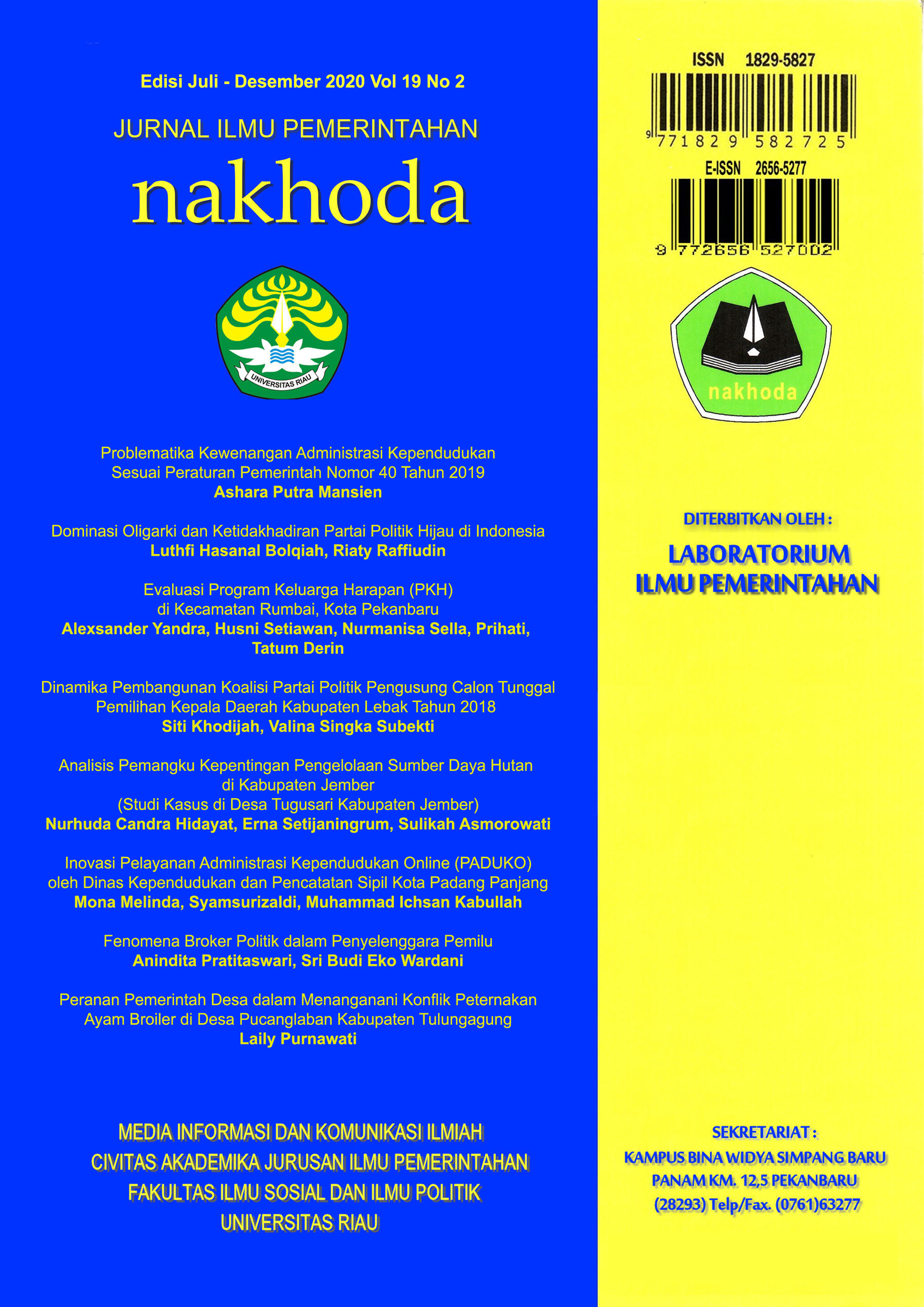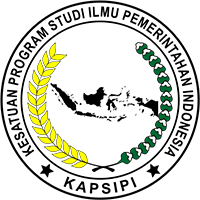Inovasi Pelayanan Administrasi Kependudukan Online (PADUKO) oleh Dinas Kependudukan dan Pencatatan Sipil Kota Padang Panjang
DOI:
https://doi.org/10.35967/njip.v19i2.115Kata Kunci:
Inovasi, Pelayanan, PADUKO, Kota Padang PanjangAbstrak
Tuntutan masyarakat terhadap pelayanan prima memaksa pemerintah melakukan berbagai inovasi. Berangkat dari hal tersebut, Dinas Kependudukan dan Pencatatan Sipil Kota Padang Panjang menciptakan inovasi Pelayanan Administrasi Kependudukan Online (PADUKO). Inovasi PADUKO mencakup sembilan belas jenis layanan kependudukan dan berhasil mendapat skor tertinggi dalam lomba inovasi organisasi pemerintah daerah Kota Padang Panjang tahun 2019. Dalam artikel ini, penulis akan mengeksplorasi inovasi (PADUKO). Penelitian ini menggunakan teori atribut inovasi oleh Everett M. Rogers yang menyatakan bahwa terdapat lima atribut inovasi yang dapat menentukan penerimaan inovasi yaitu relative advantages, compatibility, complexity, triability, dan observability. Metode penelitian dalam penelitian ini adalah metode deskriptif kualitatif dengan teknik pengumpulan data dengan melakukan wawancara, dokumentasi, dan observasi sedangkan teknik pemilihan informan melalui teknik purposive sampling. Dalam menguji keabsahan data peneliti menggunakan triangulasi sumber. Hasil penelitian menunjukkan bahwa inovasi (PADUKO) secara umum telah berjalan dengan baik dan dapat diterima masyarakat. Lima atribut inovasi yang dikemukakan oleh Everett M. Rogers juga terdapat dalam inovasi PADUKO. Hal ini dapat dilihat dari adanya keuntungan yang dirasakan berupa efektifitas waktu, efisiensi biaya dan tenaga serta sesuainya inovasi dengan kebutuhan masyarakat Kota Padang Panjang. Namun, masih ditemukan beberapa kendala seperti adanya permasalahan jaringan, server, serta permasalahan dalam aplikasi.
Unduhan
Referensi
Ahmad, E., & Brosio, G. (2009). Does decentralization enhance service delivery and poverty reduction? Does Decentralization Enhance Service Delivery and Poverty Reduction? https://doi.org/10.4337/9781849801850.00006
Albury, D. (2003). Inovasi di Sektor Publik. PT. Elex Media Komputindo.
Ariyani, A., Indah Mindarti, L., & Nuh, M. (2016). Inovasi Pelayanan Publik ( Studi pada Pelayanan Kesehatan melalui Program. Jurnal Ilmiah Administrasi Publik (JIAP).
Brinkerhoff, D. W., & Wetterberg, A. (2013). Performance-based public management reforms: Experience and emerging lessons from service delivery improvement in Indonesia. In International Review of Administrative Sciences. https://doi.org/10.1177/0020852313491059
Cahyaningrum, A., & Ardhian Nugroho, R. (2019). Inovasi Pelayanan melalui Aplikasi “Dukcapil Dalam Genggaman” oleh Dinas Kependudukan dan Pencatatan Sipil Kota Surakarta. Publikauma?: Jurnal Administrasi Publik Universitas Medan Area. https://doi.org/10.31289/publika.v7i2.2999
Hisbani, N. A., Karim, M., & Malik, & I. (2015). Penerapan Inovasi Pelayanan Publik Di Dinas Kependudukan Dan Catatan Sipil Kabupaten Enrekang. Jurnal Administrasi Publik.
Junior, M. P. (2016). Inovasi Pelayanan Publik (Studi Kuasa Perizinan Penanaman Modal di BPPT Kota Semarang). Jurnal Jurusan Ilmu Pemerintahan FISIP Universitas Diponogoro Semarang.
Kabullah, M. I. (2018). The Limits of Weberian on Anti-Corruption Approaches in the Indonesian Municipalities. IOP Conference Series: Earth and Environmental Science, 175(1). https://doi.org/10.1088/1755-1315/175/1/012083
Maolana, P., Maruao, T. F. A., Hidayani, A., Wijaya, C. S., & Ardiansyah, F. (2020). Penerapan Inovasi Pelayanan PubliK GO-DOK Di Kota Tasikmalaya. Ministrate: Jurnal Birokrasi Dan Pemerintahan Daerah. https://doi.org/10.15575/jbpd.v2i1.8022
Meyliano, R. D. P. (2015). Inovasi Pelayanan Publik di Era Disrupsi (Studi tentang Keberlanjutan Inovasi E-Health di Kota Surabaya). Journal of Chemical Information and Modeling.
Miles, M.B & Huberman, A. . (1994). An expanded sourcebook: Qualitative data analysis (2nd Edition). In Sage Publications.
Muluk, K. (2008). Kunci Sukses Inovasi Pemerintahan Daerah. Bayumedia Publishing.
Nazir, M. (2003). Metode Penelitian. Ghalia Indonesia.
Rahmi, A. (2019). Analisis Tipologi Inovasi Pelayanan Administrasi Kependudukan di Kota Padang Panjang. Universitas Andalas.
Ratminto., & Winarsih, A. S. (2013). Manajemen Pelayanan. Pustaka Belajar.
Rogers, E. M. (1995). Diffusion of Innovations, Fourth Edition. In Elements of Diffusion.
Saksono, H. (2020). INNOVATION HUB: MEDIA KOLABORASI MENUJU PEMERINTAHAN DAERAH INOVATIF. Nakhoda: Jurnal Ilmu Pemerintahan. https://doi.org/10.35967/jipn.v19i1.7854
Sedarmayanti. (2010). Manajemen Sumber Daya Manusia Reformasi Birokrasi dan Manajemen Pegawai Negeri Sipil. PT. Rafika Aditama.
Setiawan, H., & Ikhsanditya, F. (2020). GERAKAN MASYARAKAT TERTIB ADMINISTRASI KEPENDUDUKAN MELALUI INOVASI PELAYANAN LUKADESI (KELUARGA BERDUKA DESA SIAGA) DI KABUPATEN SLEMAN D.I. YOGYAKARTA. Nakhoda: Jurnal Ilmu Pemerintahan. https://doi.org/10.35967/jipn.v19i1.7853
Sugiyono. (2014). Metode Penelitian Pendidikan pendekatan Kuantitatif, Kualitatif dan R&D. In METODE PENELITIAN ILMIAH.
Suwarno, Y., & Lan, S. (2008). Inovasi Di Sektor Publik. Jurnal Administrasi Publik Unpar.
Yanuar, R. M. (2019). Inovasi Pelayanan Publik (Studi Kasus: Public Safety Center (PSC) 119 Kabupaten Bantul Sebagai Layanan Kesehatan dan Kegawatdaruratan). Jurnal Ilmu Pemerintahan.
Unduhan
Diterbitkan
Cara Mengutip
Terbitan
Bagian
Lisensi
Hak Cipta (c) 2020 Author(s)

Artikel ini berlisensiCreative Commons Attribution-NonCommercial-ShareAlike 4.0 International License.





